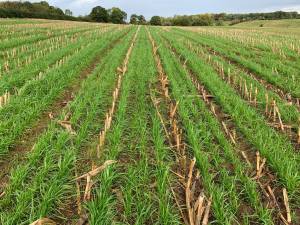Maize: Season review and post-harvest soil management with cover crops
Maize is a high-value crop with a number of uses and so it is not surprising to see that the planted area is increasing year on year. With harvest now complete, it's a good opportunity to think about the learnings from this season as well as any steps you can take to reduce overwinter soil erosion and nutrient loss following removal of the crop.
Looking back over previous seasons, I think we'd all agree no two have ever been quite the same when it comes to maize. 2021 certainly continued this trend, with crops drilled at varying dates, into an array of soils and amongst a mix of weather conditions.
With harvest over, many maize growers may have been pleasantly surprised with their crop's performance and some have even reported exceptional yields. Even so, there are always lessons to be learnt.
Drilling
Spring wasn't without its challenges. Soil conditions were quite good until early May but for growers still waiting to get the crop in the ground, rain and low temperatures in the weeks that followed meant having to stay off the fields until June. Crops that were already planted didn't escape unscathed either, as many were slow to emerge.
Weed control
Where crops had been treated with a pre-emergence, control was quite good. However, many were subjected to a follow-up post-emergence application. One weed which proved particularly troublesome this season was mayweed, especially as it flourished in wet, compacted soils.
Such challenges from weeds are not unusual though – maize is experiencing increasing threats from weeds and this makes pre- and post-emergence applications all the more important. Two-stage herbicide programmes can be a valuable insurance policy, particularly given the loss of some post-emergence actives.
Crop establishment
Unfortunately, in many areas the difficult conditions at drilling continued into crop establishment. Many early sown crops suffered delayed growth due to the adverse weather, while those sown later fought hard to catch up.
Thankfully, sunshine and warm temperatures through late June and into July boosted plant growth and encouraged cob development, getting the majority of crops back on track – particularly those which received a good nutrition programme. In some instances, growers opted for applications of foliar nitrogen at tasseling and this supported cob fill.
Nutrition
Nitrogen demand and adequate nutrient uptake is really important at flowering, applying a product such as Nutrino Pro is an efficient and crop-safe way to ensure delivery of the right nutrients at the right time. As well as delivering a controlled release of nitrogen to the crop over a number of weeks, Nutrino Pro also contains sulphur and magnesium; important for cob development, plus the pidolic and R100® acid biostimulants that improve nutrient uptake and assimilation. You can learn more about Nutrino Pro in this video.
Attention to detail is crucial for good performance
Above all, it's the most important lesson from this season. Whether you're growing maize for forage or anaerobic digestion, careful and considered management really can make all the difference. New genetic advancements and moving to early maturing varieties can be significant for the success of your maize-growing strategy but it's important to pay the same attention to your herbicide and nutrition programmes for optimum results.
Post-maize harvest – protecting your soil with cover crops
This year, thanks to the open autumn, many crops were harvested in good conditions and so the risk of soil damage was far less than would normally be the case. However, due to the nature in which maize is grown, managed and removed, it's still important to think about how you might revitalise your soils over winter where necessary. For many maize growers, planting a green cover after harvest is an excellent way to improve soil health and resilience and in some instances, the cover crop may also provide some useful forage in the autumn or early spring.
Timing is key
If you've made the decision to plant a green cover after harvest, timing is everything. Cover crops should be planted almost immediately to benefit from optimum day length, suitable seedbed temperatures and moisture availability. With an increase in the use of direct/minimum tillage drills on farm, the majority of cover crops can be drilled straight into a stubble; keeping costs and time to a minimum.
Alternatively, growers can consider undersowing maize with grass to lengthen the planting window for their cover crop. Please read our upcoming blog from Kings advisor, Jim Egan for more information on undersowing maize.
Prioritising plant locations
Particular focus on establishing post-harvest green cover should be applied to fields with slopes and those near to watercourses where risks from erosion are highest. In fact, water companies are growing increasingly interested in partnering with growers who are carrying out this work, so it's always worth looking into whether there are any local funding opportunities that may be available.
Considering your cover crop options and green cover plant species
Research into post-maize cover crop options is constant but one outcome is that cover crops choices should always complement the wider rotation. Importantly, consideration should always be given to residual herbicides applied to the previous maize crop and their prevalence post-harvest when selecting the correct cover crop. Good practice is to start preparing this through the winter months.
- Winter turnip rape
This is a quick growing, leafy forage crop that is an efficient scavenger of nutrients, very winter hardy and provides a good grazing opportunity. It can be established with the same type of equipment as that used for grass seeds.
- Mustard
Mustard is an economical, quick growing crop that will provide effective green cover. It has a long growing season, suitable for late drilling and will deliver through the autumn months. However, it is susceptible to frost.
- Oil radish
A valuable option for mopping up available nutrients and retaining soils. Oil radish can also provide a grazing option as required.
- Winter rye
This provides steady growth throughout the winter months. Winter rye would be the best option for biogas production or whole crop feed production. In line with most of our go-to herbicide strategies, the use of winter rye has great benefits although you should always seek advice from your agronomist to ensure it's the best option for you.
- Westerwolds
When sown immediately after maize, this short-term annual ryegrass should establish well before conditions deteriorate from November onwards. This crop would take a light grazing early winter but is best left until early spring in the lead up to the drilling of the next maize crop.
- Kings Catch Crop (Italian ryegrass)
This is a blend of two Italian ryegrass varieties. It will establish quickly, offers high yields and provides forage potential for up to two years where required, with intensive cutting from the following spring if needed.
- Biogas rye or triticale
These provide a green cover crop over winter and can be utilised as whole-crop forage or biogas feedstock.
- Catch crop mix (Westerwolds/Turnip rape)
A combination of grass and brassica species to capture nutrients, a catch crop mix can help improve soil structure and provide grazing as needed.
For more advice on the use of cover crops within your maize rotation please speak to your Kings advisor or contact the team. For guidance on growing maize, including variety selection and management, speak to your Frontier agronomist or get in touch. You can also subscribe to the blog here to make sure you don't miss our upcoming post on undersowing maize.
As a subscriber, you’ll receive email alerts each time a new blog is published so you can always stay updated with the latest advice and insights from our experts








Comments